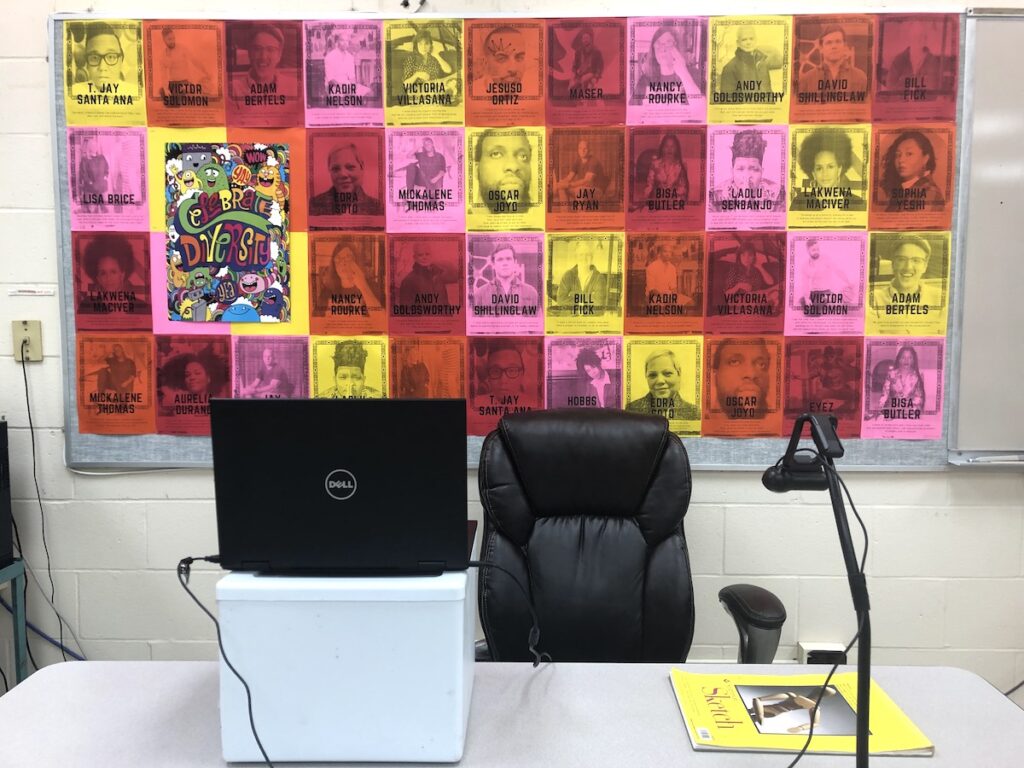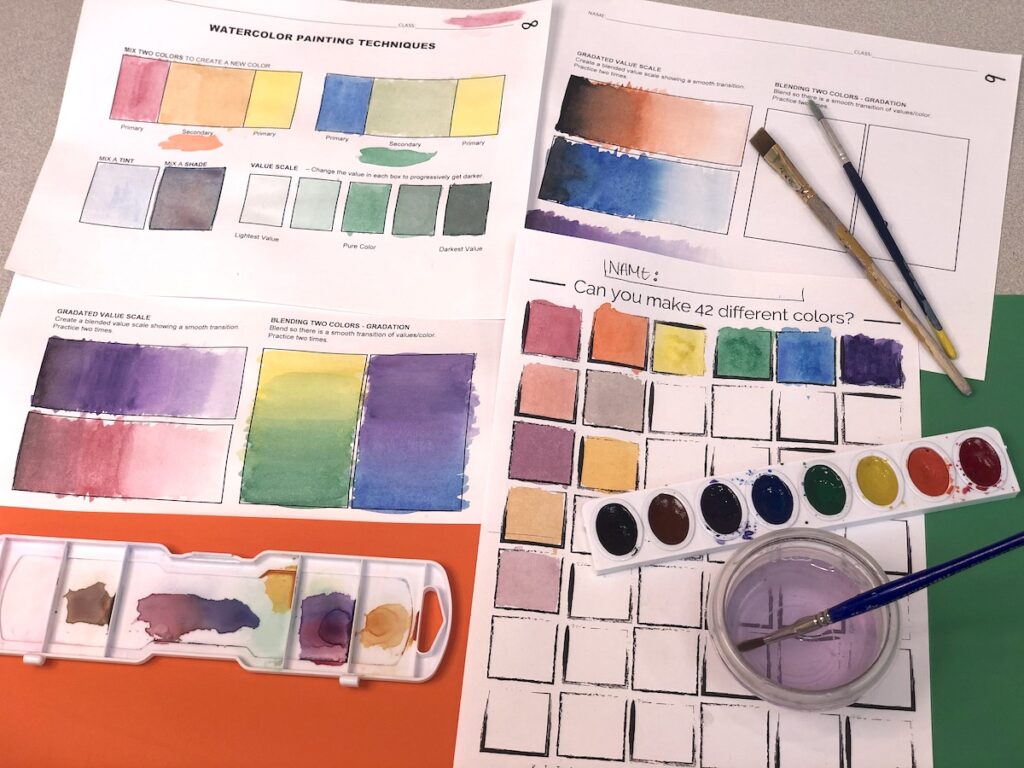Return to Learn with The Art of Education University
Middle school students have specific learning styles, interests, and challenges that make them a unique age group to work with. The art classroom can be a great outlet for students to express themselves while learning about different media and techniques. However, remote learning has changed how many of us approach our curriculum and deliver content to students. We have been so hyper-focused on doing what we think is best that we haven’t taken the time to ask our students for their opinion.

Three Ways Middle School Students Really Are Different
Below are the responses from one middle school art classroom about remote learning:
3 Things Middle School Students Like
- Teachers Who Listen to Their Suggestions: Students are not often asked for their input. When they offer their opinions or suggestions to a teacher, they are typically ignored or dismissed. In the art room, middle school students want to have a say in the projects they’re creating. Students have an extensive visual culture they would like to bring into their artwork. As their art teacher, you can encourage this interest and filter it through the student learning objectives. Unfortunately, many students have their creativity stifled by teachers who are unwilling to listen.
- Trying New Things: Remote learning certainly limits the types of projects a teacher can expect from students. Materials, resources, and technology may not be accessible to everyone. Even in these circumstances, students want to experience engaging lessons and create in new ways. For example, a simple demonstration showing students how to draw three-dimensionally and add value can be mind-blowing to students who have never learned how to draw and shade forms. Students can use simple materials like a stack of paper and a pencil to create their own flipbook animations. You can demonstrate a variety of watercolor paint techniques students have never tried before. If you can think outside the box, you can still offer your students new and exciting experiences when they log on each day!
- A Calm Classroom: Students said one thing they like about art class is that it feels more calm, quiet, and chill than some of their other classes. This can often be true of the art room when school is in person as well. The remote art room can provide a calm digital space where students work on their projects at the screen. Students can tap into that zen-like quality of creating, even when class is online. While there are lots of great websites and apps with engaging activities, sometimes less is more. Giving students time to create can provide much-needed relief during remote learning.

3 Things Middle School Students Would Change
- 5-Minute Warm-Ups: Remote learning is a strange new concept for many students. Logging on to a Zoom or Google Meets room just isn’t the same feeling as being in school. Students are learning from home and often have a lot of other distractions around them. They aren’t always ready to jump into learning at the beginning of your class. Students commented that they would like to do 5-minute warm-up drawings at the beginning of class. This can be related to the day’s content, or completely separate as just a creative challenge to get your students thinking and creating. Students can choose whether or not to share their drawings when the time is up.
- After Class Videos: While your instruction, demonstration, and presentation may be riveting, chances are, not every student is ready to create right along with you in that moment. Some may choose to work later in the day, evening, or later that week. Providing students with some video content they can watch on their own for reference can help them keep up with the class at their own pace and on their unique family schedules.
- More Choices: Students want to have a say in what they’re creating. You have the skills and techniques you’d like them to demonstrate, but if you can find ways to incorporate some student choice, you will see much more engagement. For example, if you want students to learn how to apply a value scale, you can do more than simply have them shade 3D forms. You can ask them to find an object at home like a baseball, ornament, or balloon, and shade the object using the concepts and techniques demonstrated in class.

3 Things Middle School Students Say Teachers Could Do to Improve
- Go Slower: Many of us are experiencing shorter class times, or fewer times to meet with our students due to the remote learning schedule. We feel some pressure to make the most of our time online with students and sometimes rush our instructions or demonstrations. It’s also much harder to gauge your pacing without students in the classroom with you. We’re used to picking up on when students aren’t comprehending information by seeing their progress or hearing their questions. Remote learning makes that a little harder to sense. Slow down and check for understanding often.
- Give Students Breaks: Remote learning requires students to spend a lot more time on their computer screen. We know students need opportunities to move, look away from the screen, and come back refreshed. Carve out a few minutes in your class time to allow students to get up and stretch, get a snack, and just rest their eyes. You know yourself how difficult it is to be in front of a screen all day. Allow them to take that break, so they’re able to focus more on the day’s content.
- Game-Based Learning: Students want you to find ways to help them engage with their classmates, even through remote learning. Class discussions can be intimidating, and you may find that your middle school students don’t want to be on camera or even on their microphones. Game-based learning platforms like Kahoot offer students a way to demonstrate their learning and interact with classmates in a fun and engaging way. Ask your students what platforms they are already familiar with, or ask your colleagues for recommendations.

How To Ask Your Own Students for Feedback
If you’re teaching remotely, send your students a questionnaire. You can easily use a web-based program like Google Forms to distribute your questions and review their responses. Keep the questions simple:
- What do you like about art class so far?
- What do you not like about art class so far?
- What would you like to change about art class?
- How could I improve the class for you?
Opening yourself up for students to critique does require you to be a bit vulnerable. However, feedback can be invaluable! Remote learning is relatively new to all of us, and we’ve been developing lessons and activities on the fly without asking our students how it’s all going. Take the time to find out. You will gain insight, as well as their respect.
How to Ask Your Students for Meaningful Feedback
Step One: Summarize What You’ve Learned
Once students have answered your questionnaire, take the time to review their responses. You may find many surprises, some good and some bad. The lesson you thought was a hit with everyone may have been frustrating or confusing to some in your class. Likewise, the lesson you put together in a hurry, that you felt was far too simple, may have inspired students in ways you couldn’t imagine! We’re used to seeing our classroom through our own eyes, but every once in a while, we need to change our perspective.
As you’re reading through their responses, you will start to notice themes and common answers. Make yourself a list summarizing the results of the questionnaire. What are most students enjoying about your class? What’s a common complaint or suggestion for improvement? Identify the answers you read over and over again, and jot them down. This will help you synthesize the information, and you’ll be prepared to consider some changes.
Step Two: Report Back to the Class
Your students will surely appreciate your asking for their opinion. However, simply asking is not enough if you never speak of it again. Once you’ve listed the most common responses to the questionnaire, share what you’ve learned with the class. Remind them why you valued their feedback and that you want to share some of the top responses. As you read them aloud, share how you feel about their opinions:
- “I had no idea this many of you liked perspective drawing!”
- “I see how we rushed through that watercolor project, and that was frustrating for you. I’ll work on slowing down my demonstrations so you won’t be as confused next time.”
Sharing their responses and your reflections with students will let them know you actually read their answers. They will also get some insight into how you feel and what your perceptions were of the class. This is a great exercise in building a community of respect.
Step Three: Follow Through
You’re one step closer to improving your classroom environment and curriculum. Once you’ve talked about their responses, you can start to consider and implement changes. You can eliminate or avoid activities or routines students really struggle with. You can expand more on concepts they’re interested in. Take their feedback to heart, and you may find students will open up to you more.
Of course, some of their answers will be silly and unreasonable. They are kids, after all! You can’t wave a magic wand and make all of their wishes and suggestions come true. You’re still their teacher and need to make sure they receive a quality education in your art room. However, you may find that students have a lot of great ideas about how to make the class an even better experience for all. Implement changes and highlight that you are trying something new in response to their suggestions:
- “From the questionnaire you filled out earlier this term, many of you asked for more drawing warm-up activities. Open your sketchbook and draw from the prompt on the board.”
- “I noticed on the questionnaire that your class does not enjoy splitting up into breakout rooms, so we are going to have a class discussion in the chat.”
Find More Middle School-Related Articles Below
How to Get Middle School Students Excited About Drawing
5 Activities to Open Your Middle Schoolers’ Creative Brains
How to Get Your Middle School Students to Talk About Art
5 Engaging Introductory Activities for Middle Schoolers
How to Get Your Apathetic Middle Schoolers Invested in Art
10 Insider Tips for Surviving Middle Schoolers
Final Thoughts
Periodically throughout the school year, you should ask your students for their feedback again. This one day snapshot from your questionnaire will give you a starting point, but things may change as the school year goes on. You will teach different lessons and try new teaching strategies long after the first questionnaire was reviewed. Check back in with your students a couple of weeks or months later, and see how their opinions have changed. As teachers, we are constantly working on improving our curriculum and teaching style. Let your students inform some of those changes with their feedback.
What have your students responded to most during remote learning?
What changes will you make as you approach the next quarter?
What have you learned from your students during remote learning?
Magazine articles and podcasts are opinions of professional education contributors and do not necessarily represent the position of the Art of Education University (AOEU) or its academic offerings. Contributors use terms in the way they are most often talked about in the scope of their educational experiences.





